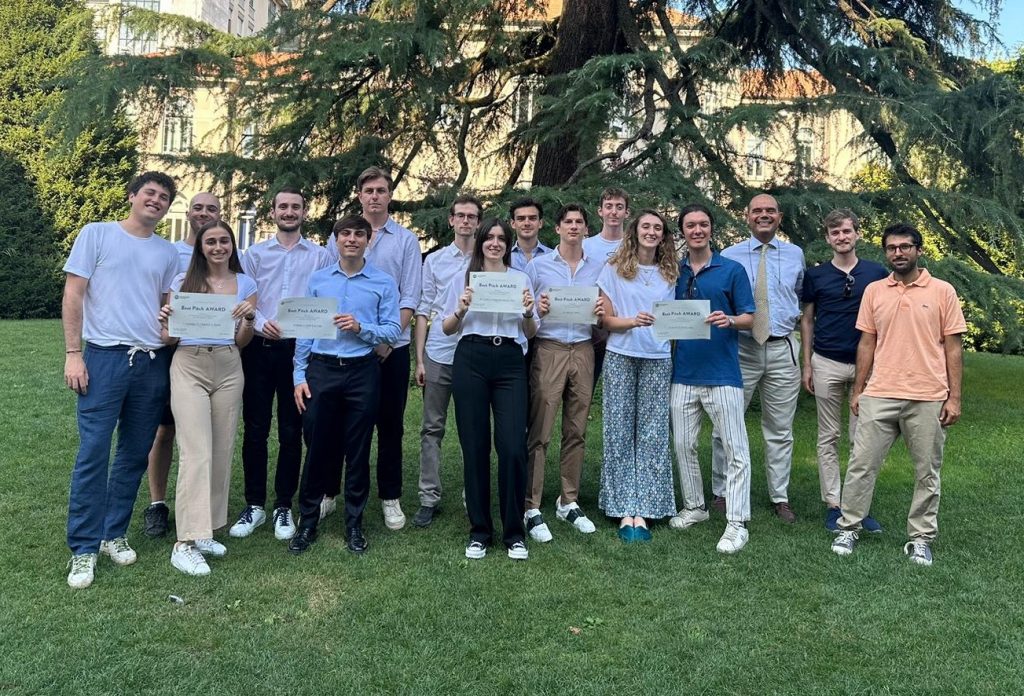
Building on the success of previous years, PoliMi Financial Engineering course once again featured the popular ‘Best Pitch’ competition. This year marked a milestone 5th edition of the ‘Best Pitch’ contest, brimming with an incredible range of fresh and captivating ideas. For a glimpse into past editions, check out the 1st, 2nd, 3rd, and 4th edition!
What is a Pitch? Why is it important?
A pitch is a quick, impactful summary designed to grab attention in a limited timeframe (about 3 min). Both for decision-makers and potential customers with a busy schedule, a well-honed pitch is the key to sparking interest and getting that crucial “tell me more”. From a financial standpoint, it can be seen as a concise investment opportunity teaser.
At its core, a winning pitch boils down to three key elements. First, you paint a clear picture of the challenge that needs a solution. Then, you unveil your answer, highlighting its innovative features and why it stands out. Finally, you wrap it up with a compelling conclusion that leaves a lasting impression.
This year 5 distinct groups obtained the ‘Best Pitch Award’ due to their capacity to highlight the best solutions to their project and capturing the jury’s attention. To have diverse and mature points of view on the pitches, the jury was composed of students, academics, and industry experts.
The winning projects of the ‘Best Pitch Award AY 2023/2024’ are:
Model risk on Regulatory Capital
Basel banking regulation requires banks to maintain a minimum capital requirement to guard against potential future unexpected losses. Two are the essential parameters in Internal Rating Based (IRB) approaches for credit capital requirements: the Probability of Default (PD) and the Loss-Given-Default (LGD). This project assesses the impact on regulatory capital of the uncertainty of each parameter separately. We’ve compared an IRB simplified calibration approach that considers only average PD and LGD, to an approach that -including the whole information on the complete distribution of PD and LGD obtained from Moody’s data and not only the mean- leads to a significant Add-On on capital requirements. Results are striking.
by Callini Matteo, Delera Giacomo
Ref. Paper: Baviera, 2022. The measure of model risk in credit capital requirements. Finance Research Letters, 44, 102064. (Open Access) doi.org/10.1016/j.frl.2021.102064
Multivariate Levy processes for Exotic Options pricing
The project addresses the challenge of pricing structured derivatives in the equity market using multivariate Lévy processes, the Lévy model is compared with the Black model to highlight their respective strengths and weaknesses. The project demonstrates that the Lévy model is advantageous for describing the market since it accurately captures volatility, however -in some cases, e.g. when the payoff depends significantly from assets’ correlation- it can be not suitable to price Exotic derivatives. Instead, for quick and efficient price estimation, the Black model appears to more satisfactory.
by Maspes Marco, Tarditi Andrea, Torba Matteo
Ref. Papers: Ballotta & Bonfiglioli, 2016. Multivariate asset models using Lévy processes and applications, The European Journal of Finance, 22:13, 1320-1350. doi.org/10.1080/1351847X.2013.870917
Simulation of Lévy-driven OU Processes
In this project, we’ve developed a library for simulating a powerful new class of mean-reverting stochastic processes: Ornstein-Uhlenbeck-Lévy and Lévy-Ornstein-Uhlenbeck. These models are adept at capturing typical behaviors characteristic of energy and commodity markets, such as seasonality, jumps, and heavy tails, and have proven to be more suitable than Gaussian-Ornstein-Uhlenbeck or basic Lévy processes. We’ve implemented two simulation schemes that represent the forefront of contemporary methodologies: the Exact Decomposition and the more efficient Fast and General Monte Carlo. These methods are then compared in terms of computational time and accuracy on prices, demonstrating the considerable time saving of the latter.
by Bencini Margherita, Corti Stefano, Giotti Jacopo
Ref. Paper: Baviera & Manzoni, 2024. Fast and General Simulation of Lévy-driven OU Processes for Energy Derivatives, 1-43. Available at arXiv:2401.15483.
The puzzle of Carbon Allowances
This project aims to solve the Puzzle of Carbon Allowance spread, an anomaly observed in the EUA market: the C-spread, i.e. the spread over the risk-free rate in the relation between future and spot prices, results -against expectations- constantly positive. Solving this market’s inefficiency can help the European Union to limit greenhouse gases emissions. We get statistical evidence that the C-spread is cointegrated with both credit spread and risk-free interest rate. In particular, we show that, in the long run, the main driver of the C-spread is the Z index, a proxy for the credit spread of EU main polluters.
by Carzaniga Carlotta, Coppola Rodolfo Emanuele, Torazzi Alessandro
Ref. Paper: Azzone, Baviera & Manzoni, 2024. The puzzle of Carbon Allowance spread, Available at SSRN 4731338.
Energy Load Forecasting
The objective is to develop a forecasting model for the electricity load for the next 24 hours, which recalibrates its parameters daily using the latest data. In our work, we’ve mainly focused on neural networks, looking for the best model to minimize the delta coverage: the difference -in absolute value- between the observed empirical coverage and the confidence level. The final model utilizes a set of parallel bidirectional LSTM layers, showing a significant improvement with respect to benchmark techniques.
by Fiecchi Silvia Alessandra Michela, Pellegrinotti Mari Paolo, Pizzo Luca

